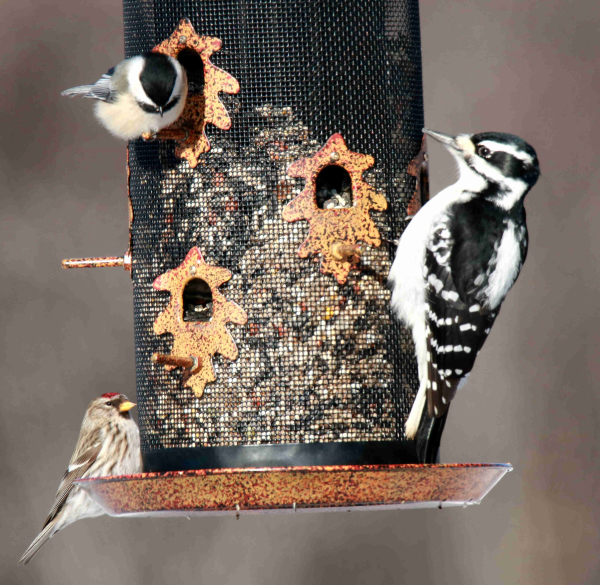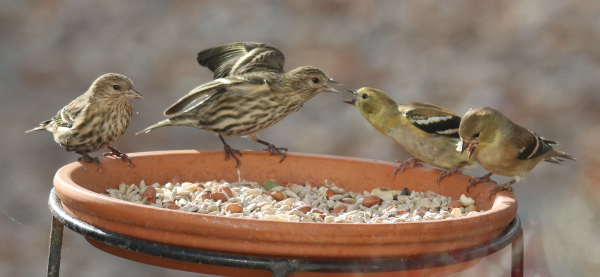
A variety of seed-eating birds will visit any feeder stocked with shelled sunflower seeds, such as this Hairy Woodpecker, Redpoll, and Black-capped Chickadee (photos by Paul Konrad).

As finch season approaches, small birds such as these Pine Siskins and American Goldfinches will prefer shelled sunflower seeds over other foods.
|
When we look back on when we started feeding birds, like many birders we bought a plastic bag of mixed seeds that included a lot of millet, red milo, and cracked corn at the hardware store. But that was before the true advent of feeding wild birds. Today, birders in the know ignore these seed mixes and, realistically, buying bird food today is much easier. We know that by simply providing black oil sunflower seeds we will attract 95 percent of the seed-eating birds we all prefer to see in our yard, and by providing fresh water we will potentially attract and benefit all birds.
Black oil sunflower seeds provide the best quality of food for wild birds because they are small enough for even goldfinches, chickadees, siskins, and nuthatches to eat, but larger birds like cardinals, woodpeckers, and jays relish them – and these seeds provide highest level of food value of any seeds.
Today, we take providing sunflower seeds a step farther by providing shelled sunflower kernels, which eliminates the mess of empty shells that are spread around the ground and pile up below feeders. It also eliminates the toil of raking, shoveling, and bagging sunflower shells that accumulate around your feeding station. And let’s be honest, there are shells discarded here and there around your yard and neighboring yards too. The shells create a mess – so don’t buy them.
Instead, purchase bags of shelled black oil sunflower seeds. They may cost a little more, but birds eat every crumb of seeds contained in a bag of shelled sunflower seeds. And you are not paying for the shells, which saves money; you don’t need to buy as many bags of sunflower seeds because shells take up a lot of space in a bag of sunflower seeds. And the shells also take up a lot of space in your feeder, which means you don’t need to fill your feeder as often if you fill it with shelled seeds. It’s a win, win, win option. At the same time, most of us like to provide a variety of quality foods, if for no other reason than to see what foods different birds prefer.
Filling Out Your Menu
Nyjer thistle seeds have always been a favorite to attract goldfinches and to avoid attracting some less welcome birds, and we usually provide nyjer seeds early in the season, but when we see that the birds we provide nyjer for are eating shelled sunflower seeds, we tend to let the nyjer run out and the birds don’t seem to notice. We have appreciated that shelled peanut halves or chips are a good option that many birds prefer, and we tend to use them as something of a treat for birds that visit our feeders regularly by adding some to the shelled sunflower seeds.
Suet is our premium year-round feeding station staple, although we provide a no-melt suet that squirrels and other mammals distain. Specifically, we offer a No-Melt Hot Pepper Suet blend that birds relish, including woodpeckers, nuthatches, jays, and ground-oriented birds like juncos, native sparrows, and others feed on small pieces that fall below the suet feeder as a result of other birds’ feeding efforts. As we write this, it’s come to mind that maybe it would be a good idea to smash a bit of suet into crumbs for the cadre of ground foraging birds – yes, we are going to try that.
What else? Water of course. Fresh water attracts a greater variety of birds than any given food offered at a feeding station, and every bird needs water in some form. The sound of moving water will alert migrating birds that take a stopover break that there is water available in your bird bath or water feature. And with leaves changing colors across half of the country now, freezing temperatures will soon require us to plug in our heated bird bath – or appreciate our solar-headed bird bath all the more. The main thing with water is to keep it fresh and don’t let the water vessel go dry.
Back to black oil sunflower seeds, it’s all a matter of personal preferences, but we offer our best take on the subject here, along with a full menu of bird foods and water to keep your feeding station active throughout the days of fall, winter, and spring! Enjoy the action, and enjoy the parade of birds that is just beginning to make October even more exciting!
Share your backyard birding experiences and photographs with The Birding Wire at editorstbw2@gmail.com